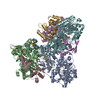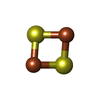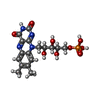[English] 日本語
 Yorodumi
Yorodumi- PDB-7q4w: CryoEM structure of electron bifurcating Fe-Fe hydrogenase HydABC... -
+ Open data
Open data
- Basic information
Basic information
| Entry | Database: PDB / ID: 7q4w | |||||||||||||||||||||
|---|---|---|---|---|---|---|---|---|---|---|---|---|---|---|---|---|---|---|---|---|---|---|
| Title | CryoEM structure of electron bifurcating Fe-Fe hydrogenase HydABC complex A. woodii in the oxidised state | |||||||||||||||||||||
 Components Components | (Iron hydrogenase ...) x 3 | |||||||||||||||||||||
 Keywords Keywords | ELECTRON TRANSPORT / flavin-based electron bifurcating hydrogenase / FeFe hydrogenase / nicotine amide adenine dinucleotide / ferredoxin | |||||||||||||||||||||
| Function / homology |  Function and homology information Function and homology informationferredoxin hydrogenase / ferredoxin hydrogenase activity / NADH dehydrogenase (ubiquinone) activity / ATP synthesis coupled electron transport / 2 iron, 2 sulfur cluster binding / FMN binding / 4 iron, 4 sulfur cluster binding / iron ion binding / metal ion binding / membrane Similarity search - Function | |||||||||||||||||||||
| Biological species |  Acetobacterium woodii DSM 1030 (bacteria) Acetobacterium woodii DSM 1030 (bacteria) | |||||||||||||||||||||
| Method | ELECTRON MICROSCOPY / single particle reconstruction / cryo EM / Resolution: 3.78 Å | |||||||||||||||||||||
 Authors Authors | Kumar, A. / Saura, P. / Poeverlein, M.C. / Gamiz-Hernandez, A.P. / Kaila, V.R.I. / Mueller, V. / Schuller, J.M. | |||||||||||||||||||||
| Funding support | 6items
| |||||||||||||||||||||
 Citation Citation |  Journal: J Am Chem Soc / Year: 2023 Journal: J Am Chem Soc / Year: 2023Title: Molecular Basis of the Electron Bifurcation Mechanism in the [FeFe]-Hydrogenase Complex HydABC. Authors: Alexander Katsyv / Anuj Kumar / Patricia Saura / Maximilian C Pöverlein / Sven A Freibert / Sven T Stripp / Surbhi Jain / Ana P Gamiz-Hernandez / Ville R I Kaila / Volker Müller / Jan M Schuller /   Abstract: Electron bifurcation is a fundamental energy coupling mechanism widespread in microorganisms that thrive under anoxic conditions. These organisms employ hydrogen to reduce CO, but the molecular ...Electron bifurcation is a fundamental energy coupling mechanism widespread in microorganisms that thrive under anoxic conditions. These organisms employ hydrogen to reduce CO, but the molecular mechanisms have remained enigmatic. The key enzyme responsible for powering these thermodynamically challenging reactions is the electron-bifurcating [FeFe]-hydrogenase HydABC that reduces low-potential ferredoxins (Fd) by oxidizing hydrogen gas (H). By combining single-particle cryo-electron microscopy (cryoEM) under catalytic turnover conditions with site-directed mutagenesis experiments, functional studies, infrared spectroscopy, and molecular simulations, we show that HydABC from the acetogenic bacteria and employ a single flavin mononucleotide (FMN) cofactor to establish electron transfer pathways to the NAD(P) and Fd reduction sites by a mechanism that is fundamentally different from classical flavin-based electron bifurcation enzymes. By modulation of the NAD(P) binding affinity via reduction of a nearby iron-sulfur cluster, HydABC switches between the exergonic NAD(P) reduction and endergonic Fd reduction modes. Our combined findings suggest that the conformational dynamics establish a redox-driven kinetic gate that prevents the backflow of the electrons from the Fd reduction branch toward the FMN site, providing a basis for understanding general mechanistic principles of electron-bifurcating hydrogenases. | |||||||||||||||||||||
| History |
|
- Structure visualization
Structure visualization
| Structure viewer | Molecule:  Molmil Molmil Jmol/JSmol Jmol/JSmol |
|---|
- Downloads & links
Downloads & links
- Download
Download
| PDBx/mmCIF format |  7q4w.cif.gz 7q4w.cif.gz | 412.6 KB | Display |  PDBx/mmCIF format PDBx/mmCIF format |
|---|---|---|---|---|
| PDB format |  pdb7q4w.ent.gz pdb7q4w.ent.gz | 331.7 KB | Display |  PDB format PDB format |
| PDBx/mmJSON format |  7q4w.json.gz 7q4w.json.gz | Tree view |  PDBx/mmJSON format PDBx/mmJSON format | |
| Others |  Other downloads Other downloads |
-Validation report
| Summary document |  7q4w_validation.pdf.gz 7q4w_validation.pdf.gz | 1.4 MB | Display |  wwPDB validaton report wwPDB validaton report |
|---|---|---|---|---|
| Full document |  7q4w_full_validation.pdf.gz 7q4w_full_validation.pdf.gz | 1.5 MB | Display | |
| Data in XML |  7q4w_validation.xml.gz 7q4w_validation.xml.gz | 64.9 KB | Display | |
| Data in CIF |  7q4w_validation.cif.gz 7q4w_validation.cif.gz | 98.8 KB | Display | |
| Arichive directory |  https://data.pdbj.org/pub/pdb/validation_reports/q4/7q4w https://data.pdbj.org/pub/pdb/validation_reports/q4/7q4w ftp://data.pdbj.org/pub/pdb/validation_reports/q4/7q4w ftp://data.pdbj.org/pub/pdb/validation_reports/q4/7q4w | HTTPS FTP |
-Related structure data
| Related structure data |  13819MC  7q4vC  8a5eC  8a6tC  8bewC M: map data used to model this data C: citing same article ( |
|---|---|
| Similar structure data | Similarity search - Function & homology  F&H Search F&H Search |
- Links
Links
- Assembly
Assembly
| Deposited unit | 
|
|---|---|
| 1 |
|
- Components
Components
-Iron hydrogenase ... , 3 types, 6 molecules AEBFCG
| #1: Protein | Mass: 63692.887 Da / Num. of mol.: 2 / Source method: isolated from a natural source / Source: (natural)  Acetobacterium woodii DSM 1030 (bacteria) / References: UniProt: H6LFG3, ferredoxin hydrogenase Acetobacterium woodii DSM 1030 (bacteria) / References: UniProt: H6LFG3, ferredoxin hydrogenase#2: Protein | Mass: 50264.406 Da / Num. of mol.: 2 / Source method: isolated from a natural source / Source: (natural)  Acetobacterium woodii DSM 1030 (bacteria) / Strain: ATCC 29683 / DSM 1030 / JCM 2381 / KCTC 1655 / WB1 / References: UniProt: H6LFG4, ferredoxin hydrogenase Acetobacterium woodii DSM 1030 (bacteria) / Strain: ATCC 29683 / DSM 1030 / JCM 2381 / KCTC 1655 / WB1 / References: UniProt: H6LFG4, ferredoxin hydrogenase#3: Protein | Mass: 16999.689 Da / Num. of mol.: 2 / Source method: isolated from a natural source / Source: (natural)  Acetobacterium woodii DSM 1030 (bacteria) / References: ferredoxin hydrogenase Acetobacterium woodii DSM 1030 (bacteria) / References: ferredoxin hydrogenase |
|---|
-Non-polymers , 4 types, 22 molecules 






| #4: Chemical | ChemComp-SF4 / #5: Chemical | ChemComp-FES / #6: Chemical | #7: Chemical | |
|---|
-Details
| Has ligand of interest | Y |
|---|
-Experimental details
-Experiment
| Experiment | Method: ELECTRON MICROSCOPY |
|---|---|
| EM experiment | Aggregation state: PARTICLE / 3D reconstruction method: single particle reconstruction |
- Sample preparation
Sample preparation
| Component | Name: Homodimer complex of HydABC trimer / Type: COMPLEX / Entity ID: #1-#3 / Source: NATURAL |
|---|---|
| Molecular weight | Value: 350 kDa/nm / Experimental value: YES |
| Source (natural) | Organism:  Acetobacterium woodii DSM 1030 (bacteria) Acetobacterium woodii DSM 1030 (bacteria) |
| Buffer solution | pH: 7.6 |
| Specimen | Embedding applied: NO / Shadowing applied: NO / Staining applied: NO / Vitrification applied: YES |
| Vitrification | Cryogen name: ETHANE-PROPANE |
- Electron microscopy imaging
Electron microscopy imaging
| Experimental equipment |  Model: Titan Krios / Image courtesy: FEI Company |
|---|---|
| Microscopy | Model: FEI TITAN KRIOS |
| Electron gun | Electron source:  FIELD EMISSION GUN / Accelerating voltage: 300 kV / Illumination mode: FLOOD BEAM FIELD EMISSION GUN / Accelerating voltage: 300 kV / Illumination mode: FLOOD BEAM |
| Electron lens | Mode: BRIGHT FIELD / Nominal defocus max: 2000 nm / Nominal defocus min: 800 nm |
| Image recording | Electron dose: 55 e/Å2 / Film or detector model: GATAN K3 (6k x 4k) |
- Processing
Processing
| CTF correction | Type: PHASE FLIPPING AND AMPLITUDE CORRECTION |
|---|---|
| 3D reconstruction | Resolution: 3.78 Å / Resolution method: FSC 0.143 CUT-OFF / Num. of particles: 250709 / Symmetry type: POINT |
 Movie
Movie Controller
Controller






 PDBj
PDBj



















